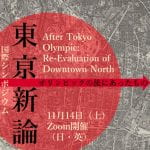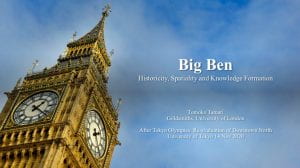
International Symposium ‘After Tokyo Olympic: Re-Evaluation of Downtown North, organized by Interfaculty Initiative in Information Studies, The University of Tokyo
Mike Featherstone and Tomoko Tamari were invited as keynote speakers and discussed city landscape and history.
City Images, Cityscapes and the Tokyo 2020 Olympics, Mike Featherstone
The Olympic Games is an event that shows the face of the city on the global stage. Yet this raises the question of how city images are generated and become iconic? In the case of Tokyo, Mount Fuji is often pulled in from the landscape to stand for the city as a whole. This paper focuses on the generation of the Tokyo image for the 2020 Olympics in relation to the more varied and multiple images of cityscapes and streetscapes. But also examines the dependence on various infrastructures (the hidden underground utilities) and Infostructures (the city of sensors generating data and ‘smartification’ processes).

Tokyo Olympics 2020: How to make the most of your visit to Japan, Good Housekeeping, 2019
Big Ben: Historicity, Spatiality and Knowledge Formation, Tomoko Tamari
The aim of this paper is to re-contextualize London’s landscape from the spatial-historical perspective. By doing so, the paper attempts to demonstrate how landscape as a space, is fundamental in various cultural forms in the history. There are many iconic architectures and landscapes in London, but I particularly focus on Big Ben. Drawing on Foucault’s notion of the heterotopia, the paper explores how space plays in our history. In his book The Order of Things, heterotopias had described Borges’ Chinese Encyclopaedia, which indicates non-linear form of memory and knowledge. This opened up Foucault’s ideas on knowledge production, classification and ordering. For him, heterotopias act as ‘counter-sites, spaces in contestation of, or in contrast or opposition to’ other sites (Genocchio cited in Topinka 2010). Such contestation creates crucial conditions to generate new ways of ordering and to evoke new classification. Hence heterotopias can be seen as spaces to store and invert the existing knowledge and to create conditions for new knowledge formation will emerge. Big Ben as a heterotopic space which cannot be considered as the fixed and singular, but it can be seen as ‘many spaces in one site’. It can, therefore, be seen as a contested space, which evokes new knowledge and classification will be formed. Big Ben as a space offers ‘spatial histories’ and new ways of knowing of social life. Hence, this suggests that space is historical and ‘a history framed as a history of the present’, Stuart Elden claims.
